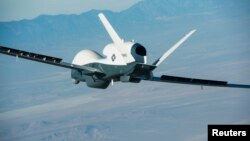Washington residents were startled in April 2017 to see a low-flying aircraft transit directly through the normally restricted airspace at the center of the U.S. capital, with all its monuments and iconic government buildings.
Many were more surprised to learn that the aircraft in question was a Russian Tupolev Tu-154 surveillance plane and that the mission had been approved in advance by U.S. authorities.
The incident called attention to the Open Skies Treaty, a 1992 pact in which the United States, Russia and 32 other countries agree to permit such unarmed missions under strictly controlled conditions.
The idea, first put forward in the 1950s, is that everyone is safer if they know what everyone else is doing. Almost 100 such flights are conducted each year.
There have been calls for the United States to withdraw from the treaty of late, with an influential senator and members of the Trump administration accusing Russia of violations that, they say, have given that country an unfair advantage.
Nevertheless, the agreement looks more secure after last month’s enactment of the National Defense Authorization Act of 2020 (NDAA). A little noticed provision in the mammoth bill funded a new aircraft for the American spy flights – now conducted with a 60-year-old plane -- and required President Donald Trump to give Congress four-months notice before seeking to pull out of it.
Specific language in the bill says the United States should "commit to continued participation in the treaty" and "forcefully address Russian violations of its obligations” under the agreement.
The treaty requires countries planning surveillance flights to notify the host country of its plans in advance and to permit personnel from the host country to be on board the plane.
But critics, including Arkansas Senator Tom Cotton, chairman of the Armed Services Subcommittee on Airland, have focused on Russia’s restrictions on flights over certain sensitive areas, including the Kaliningrad region and along its border with contested parts of the republic of Georgia.
They also charge that Moscow is using the flights to identify and examine vital American infrastructure and claim that one flight even overflew a Trump-owned golf course at Bedminster, New Jersey. The latter claim has been challenged.
Supporters of the treaty insist that the benefits outweigh the risks, arguing that its value was demonstrated after the Russian Navy seized 24 Ukrainian sailors and their vessels near the Kerch Strait in November 2018.
Two weeks later, a U.S. OC-135B Boeing aircraft was able to fly over the area with representatives of Canada, Germany, France, Romania and Britain on board to document any possible provocations.
"Following Russia’s unprovoked attack on Ukrainian vessels near the Kerch Strait, the United States and United States allies conducted an ‘extraordinary’ Open Skies Treaty observation mission over Ukraine to reaffirm commitment to Ukraine," the NDAA text points out.
The overflight sent an important signal to Russia, argues Iain King of the Center for Strategic and International Studies, a Washington research organization.
"The Open Skies Treaty allowed Ukraine to have an overflight of the area to see what Russia was doing behind their lines, to know where Russia was positioning its military assets, to know what was going to come in the future. “
That sent an important message to Moscow. It also gave Kyiv very welcome information about what to expect in the area."
Jim Townsend, a former deputy assistant secretary of defense, says the agreement also showed its value following Russia’s annexation of Crimea.
"I think Ukraine is a great example of how the nations in the West acted when the Russians invaded Crimea," said Townsend, whose areas of responsibility included NATO and Europe.
"One of the first things we did was to put up these airplanes through the Open Skies agreement so that we could, at a minimum, signal the Russians that we were watching what they were doing, that they were not going to be able to spin a story that was a lie about what their forces were doing."
King said the overflights enable the United States to gather certain types of information that cannot be obtained with spy satellites, which can be hampered by cloud cover.
The treaty also authorizes the flight operators to “use optical centering and heat centering to know how much fuel there is in military assets – tanks, airplanes on the ground,” he said. "That gives you an insight into whether those assets are about to be used. You could do that with Open Skies. You can't do that with satellites."










